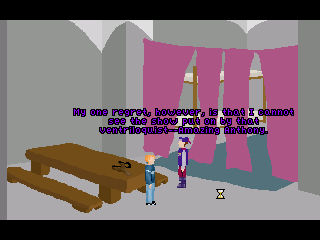Why hello, random people. You seem to have stumbled upon this month’s issue of testgame.exe: Making the Adventure. What is this strange creation, you ask? Well, it appears to have something to do with videogames, or else it wouldn’t be in GameCola. Am I right?
In any case, to continue with our monthly foray into the world of small-scale point-and-click adventure game production, I will remind you that last month marked the emergence of the ability to get the third and final signature on Amazing Anthony’s petition. And now, gentle readers, I bring to you thecompletion of the petition puzzle. That’s right: As of this month, you will be able to bring the signed petition to Amazing Anthony and get him to begin planning for his new and improved show. And then the show happens. Well, to clarify: You don’t actually get to see the show yet because I haven’t programmed it yet. All in good time, my friends.
And now the question becomes this: Can you, the player, actually get anywhere after completing this puzzle? Well, no, of course not. Because as it turns out, the completion of the petition puzzle needs to happen in conjunction with the completion of another puzzle in order for Paul to really progress in the main story. And I am here to tell you, gentle readers, that this month’s update of testgame also introduces that other puzzle, although you may not be able to do very much about it yet. This puzzle has been planned for a while, but now you finally get to find out about it. I’ll give you a hint: it has something to do with the guard captain.
I’d also like to point out that I’ve now fleshed out the third part of the signature puzzle that debuted last month. There’s new animation, and a few interactions that I felt needed to be there to make the whole thing work better.
Also, one of the big new things that I tried programming in testgame this month is a timer. After much deliberation, I have come to the conclusion that timers are confusing. I’ve done some things with keeping track of time in the game before now (see the computer in Paul’s room), but never on as large a scale as this, and that way wouldn’t really work in this case. I opted out of using the built-in timer function that came with AGS because I wanted the player to be able to check how much time is left on the timer (as far as I can tell, you can’t do that with the built-in timer). In the end, I had to do something fairly tricky: having my timer continually counting in the background, even during cutscenes and dialogue, but then only checking to see if the timer has run out when the game is allowed to do something about it (i.e., not during cutscenes and dialogue).
To conclude, I’m feeling fairly pleased with the sort of pace at which testgame is coming along. Why don’t you fellows give this month’s update a try, yes? I’ll be checking the comments section of this article, if you have any questions/suggestions.
(no extra programs needed to run this file)
Things to do/new features of note:
-
Ability to give the (signed!) petition back to Amazing Anthony, and stuff happens!
-
Framework for Amazing Anthony’s second show. You can’t actually see the show yet, but as of right now, Paul will tell you when it’s happening (there’s a timer involved), and the game is programmed to know about the various aspects of the show, whether Paul has seen it, etc. Once you set it up, you can also talk to Amazing Anthony to find out how much time it will be until the show starts.
-
New dialogue with the guard captain! Be sure to try talking to him after getting the petition.
-
Ability to look at, interact with, and talk to Toddy (or at least you can try to talk to him).
-
Mrs. Whittle now looks to the right when she needs to reprimand Paul for bothering her son.
-
New picture for the stick inventory item.
-
The petition now appears as an object in the courtyard side screen when it’s supposed to, and you can interact with it (i.e. pick it up again).
-
Ability to use the stick with Toddy.
-
New animation for Toddy after you use a particular item on him (sort of, but not really).
All the graphics and design are by Lizo. The dialogue was written by Lizo, with significant input by Paul. The background music is by Lizo. “Let’s Go Skateboard” is written and performed by The Word Problems. Adventure Game Studio (the program used to create this game) can be downloaded at http://www.adventuregamestudio.co.uk/

